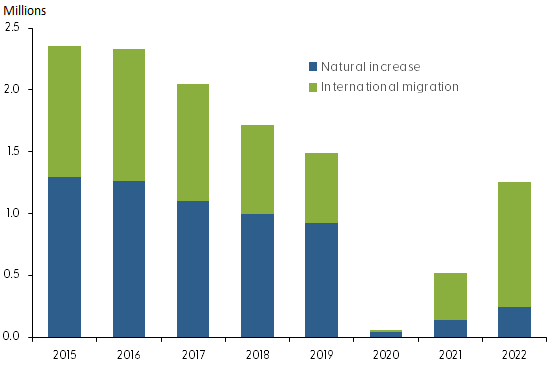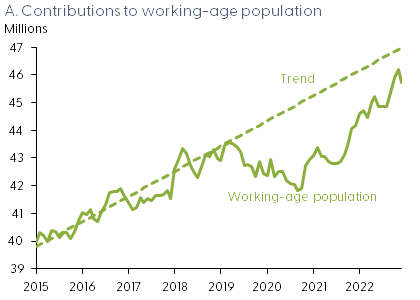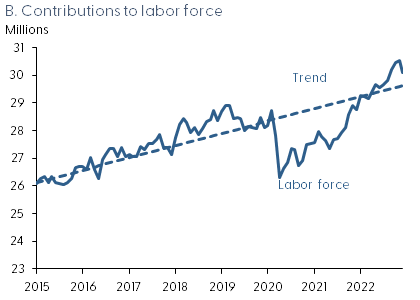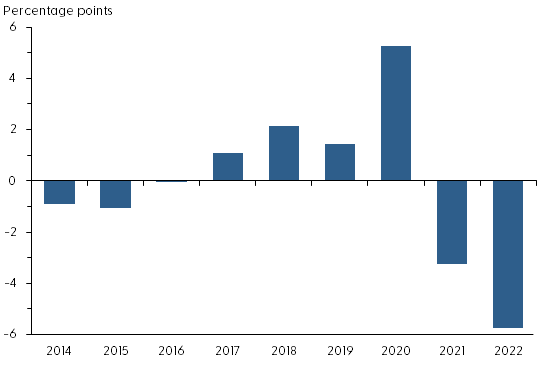Immigrants contribute a large portion of the growth in the U.S. population and labor force. However, immigration flows into the United States slowed significantly following immigration policy changes from 2017 to 2020 and the onset of the COVID-19 pandemic. Analysis of state-level data shows that this migration slowdown tightened local labor markets modestly, raising the ratio of job vacancies to unemployed workers 5.5 percentage points between 2017 and 2021. More recent data show immigration has rebounded strongly, helping to close the shortfall in foreign-born labor and ease tight labor markets.
Immigration has traditionally provided an important contribution to the U.S. labor force. The flow of immigrants into the United States began to slow in 2017 due to various government policies, then declined further due to border closures in 2020–21 associated with the COVID-19 pandemic. This decline in immigration has had a notable effect on the share of immigrants in the U.S. labor force. For instance, Peri and Zaiour (2022) estimate that the pandemic led to 2 million fewer foreign working-age people in 2021 relative to the pre-2019 trend. More recent data from November 2022 show a significant pickup in immigration flows, narrowing this shortfall and returning numbers to the pre-pandemic level.
This Economic Letter explores the impact of recent changes to immigration flows on the labor market. I assess the labor market using the vacancy-to-unemployment (V–U) ratio, which is a well-known measure of the degree of labor market tightness, with a higher V–U ratio indicating a tighter labor market (Barnichon and Shapiro 2022). While gradual inflows of immigrants into the United States have historically tended to loosen labor markets, the sharp drop in immigration between 2017 and 2021 helped fuel a strong tightening in labor market conditions. I find that slowing immigration led to a 5.5 percentage point increase in the V–U ratio over this period. Data for 2022 show a strong rebound in immigration that has helped offset tight U.S. labor markets by contributing a 6 percentage point reduction in the V–U ratio.
Labor market tightness and its contributing factors
One way to measure the strength of the labor market is to compare the number of vacant positions employers would like to fill to the number of people looking for jobs. An elevated vacancy-to-unemployment (V–U) ratio indicates a tight labor market in which jobs are plentiful and unemployed workers are scarce.
The V–U ratio can vary for many reasons, such as overall economic activity or changes in technology that result in jobs being automated. In this Letter, I focus on the impact of the size of the labor force, that is, on the supply of workers. In particular, new entrants into the labor force can lower the V–U ratio by either filling open positions or joining the ranks of the unemployed looking for work.
A central force for expanding the labor force is a growing population. This occurs through either natural increases—more domestic births than deaths—or through more immigrants arriving than the number of people leaving the country. U.S. domestic-born population growth has slowed in recent years through low fertility rates and the aging of the baby-boom generation. Figure 1 shows the contributions to annual growth in the U.S. population from natural increases (blue bars) and net international migration (green bars). Net international migration (NIM) accounts for both immigration and emigration between the United States and the rest of the world.
Figure 1
Annual U.S. population change, 2015–22

Source: Author’s calculations using national population projections from U.S. Census Bureau.
Recent population growth changed dramatically. Whereas the foreign-born population grew 1.6% per year on average in the decade leading up to 2017, growth slowed to 0.45% per year in 2018 and 2019 before coming to nearly a complete stop in 2020. NIM then picked up in 2021 before a substantial rebound in 2022.
Role of immigration in population and labor force growth
Immigrants contribute to the U.S. economy through the supply of labor as well as through entrepreneurship. Entrepreneurs increase the demand for labor by creating job vacancies and therefore increasing labor tightness (Azoulay et al. 2022). However, the primary way recent entrants affect the U.S. labor market is by increasing labor supply, since they are more likely to work than demand labor services.
Much of the pre-COVID decline in immigration can be attributed to immigration policies enacted after January 2017. Over the course of four years, 472 executive actions were aimed at transforming the U.S. immigration system (Bolter, Israel, and Pierce 2022). These actions ranged broadly from increasing immigration enforcement to temporarily freezing refugee admissions and moving away from family immigration through the Reforming American Immigration for Strong Employment (RAISE) Act. Following these immigration policies, NIM fell significantly. Between 2016 and 2019 the number of new permanent residents dropped 13% and the number of student (F1) visas issued declined 23%. Nevertheless, these policies turned out to have a relatively modest impact compared with the border closures used as a pandemic mitigation strategy.
The overall impact of these policies and the pandemic can be seen by comparing the actual working-age foreign-born population and labor force with the level predicted by the average growth trend for 2010–16. Panel A of Figure 2 shows that the growth in the foreign-born working-age population slowed down such that, just before the pandemic, it was about 1.5 million people below what would have been predicted by its trend growth. This gap widened to 2 million people by the end of 2021, a shortfall noted by Peri and Zaiour (2022). Since then, however, immigration has rebounded, nearly closing the population gap with its pre-pandemic trend by the end of 2022.
Figure 2
Foreign-born worker contributions and pre-2017 trends


Source: Current Population Survey (CPS) and author’s calculations. Series are calculated as monthly rates using CPS data, with the trends based on growth from January 2010 to December 2016.
To get a better understanding of how these changes have impacted the U.S. labor market, I also look at growth in the number of foreign-born individuals in the labor force, which measures people working or looking for work. I again assess the gap between the actual number of foreign-born individuals in the labor force relative to the level predicted by its 2010–16 trend. Panel B of Figure 2 shows that the overall pattern for the foreign-born labor force relative to its trend is broadly similar to that of the foreign-born working-age population, albeit with an even stronger recovery: the shortfall in the foreign-born labor force closed by the middle of 2022.
Connection between immigration and labor tightness
To explore the impact of immigration on labor markets, I examine variation in the V–U ratio and NIM across states. Most U.S. states have experienced a notable increase in the V–U ratio in recent years. As native-born worker migration rates across states have declined in recent decades (see Kerns-D’Amore, Marshall, and McKenzie 2022), foreign-born workers have been filling gaps in local labor markets. Furthermore, Cadena and Kovak (2016) show that low-skilled immigrants are more likely than native workers to travel to states with higher demand for labor. Similarly, one would expect that foreign-born workers would respond more than native workers to rising labor demand in states that typically attract more immigrants and have an above-average share of foreign-born population.
However, despite tightening labor markets and increased labor demand across the United States between 2017 and 2019, NIM was down in all but six states. In fact, most regions that gained immigrants have relatively low shares of foreign-born population. These states generally do not display a strong change in V–U ratios from changes in immigration flows because immigrants make up a smaller share of their local labor markets. In contrast, states with an above-average concentration of immigrants have a negative relationship between changes in NIM and the V–U ratio, such that the V–U ratio falls as the NIM rises. Therefore, states with a higher proportion of foreign-born workers typically experience stronger labor market tightening after a decline in NIM.
To more precisely estimate the effects of changes in NIM on labor market tightness, I use the differences in immigration rates across states and over time. I estimate the impact of changing NIM flows on labor tightness across states using the annual Job Openings and Labor Turnover Survey and American Community Survey state data from 2006 to 2021. I measure changes in NIM relative to a state’s resident population in 2000. Regression analysis indicates that higher NIM is associated with lower labor tightness. This highlights the effects of both decreasing immigration, where fewer foreign-born workers enter the labor market, and rising emigration of foreign-born workers out of state.
In addition, Figure 3 reports the average contribution of changes in NIM to the tightening in local labor markets. Positive values indicate that, on average, lower NIM increased labor market tightness. Prior to immigration policy changes beginning in 2017, NIM was increasing, thereby lowering the V–U ratio, albeit by a small amount. Slower immigration during 2017–20 contributed to an average increase in V–U. Pandemic-related policies led to an unprecedented drop in NIM at the same time as a sharp decrease in the V–U ratio when many businesses closed. As a result, declines in NIM in 2020 increased the V–U ratio about 5 percentage points, offsetting some of the reduction due to direct pandemic effects on the labor market. Subsequently, a strong immigration surge in 2022 led to an outsized increase in NIM. This helped alleviate some of the labor market tightness: according to regression estimates, the increase in NIM brought the V–U ratio down almost 6 percentage points, somewhat offsetting an overall increase in the ratio in 2022.
Figure 3
Net immigration contributions to changes in V-U ratio

Source: Author’s calculations using data from Bureau of Labor Statistics and U.S. Census Bureau.
However, while variations in NIM impact labor market conditions, their average contributions to changes in the V–U ratio were relatively muted in most years. The exception is 2019, when the decline in NIM accounted for roughly a quarter of the small rise in the V–U ratio.
Conclusion
Immigration policies enacted after January 2017 contributed to the decline in immigration prior to the sharp drop due to the COVID-19 border closures. Lower net international migration led to a slowdown in the foreign-born population and labor force growth. This contributed to the tightening in the U.S. labor market. Reopening of borders in 2022 and easing of immigration policies brought a sizable immigration rebound, which in turn helped alleviate the shortage of workers relative to job vacancies. The foreign-born labor force grew rapidly in 2022, closing the labor force gap created by the pandemic. This analysis suggests that, if the pickup in immigration flows continues, it could further ease overall labor market tightness, albeit by a modest amount.
Evgeniya A. Duzhak
Regional Policy Economist, Economic Research Department, Federal Reserve Bank of San Francisco
References
Azoulay, Pierre, Benjamin F. Jones, J. Daniel Kim, and Javier Miranda. 2022. “Immigration and Entrepreneurship in the United States.” American Economic Review: Insights 4(1), pp. 71–88.
Barnichon, Regis, and Adam Shapiro. 2022. “What’s the Best Measure of Economic Slack?” FRBSF Economic Letter 2022-04 (February 22).
Bolter, Jessica, Emma Israel, and Sarah Pierce. 2022. Four Years of Profound Change: Immigration Policy during the Trump Presidency. Washington, DC: Migration Policy Institute.
Cadena, Brian C., and Brian K. Kovak. 2016. “Immigrants Equilibrate Local Labor Markets: Evidence from the Great Recession.” American Economic Journal: Applied Economics 8(1), pp. 257–290.
Kristin Kerns-D’Amore, Joey Marshall, and Brian McKenzie. 2022. “Pandemic Did Not Disrupt Decline in Rate of People Moving.” U.S. Census Bureau, America Counts: Stories Behind the Numbers, March 7.
Peri, Giovanni, and Reem Zaiour. 2022. “Labor Shortages and the Immigration Shortfall.” EconoFact, January 11.
Opinions expressed in FRBSF Economic Letter do not necessarily reflect the views of the management of the Federal Reserve Bank of San Francisco or of the Board of Governors of the Federal Reserve System. This publication is edited by Anita Todd and Karen Barnes. Permission to reprint portions of articles or whole articles must be obtained in writing. Please send editorial comments and requests for reprint permission to research.library@sf.frb.org
